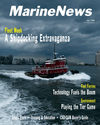
Page 29: of Marine News Magazine (July 2005)
Read this page in Pdf, Flash or Html5 edition of July 2005 Marine News Magazine
as it is a lifesaving technique common to all fire fighters. The hose is put together with male and female couplings. Knowing that the male coupling leads to the fire and the female coupling leads to the pump panel, or out of the building, is absolutely critical for survival and passage through the obscurity of smoke. "To effectively fight shipboard fires while underway, we need to train crews with the skills and equipment used by pro- fessional fire fighters," says Glen Paine,
Executive Director of the Maritime Insti- tute of Technology and Graduate Studies (MITAGS) and the Pacific Maritime Insti- tute (PMI). "Our students are taught the basic principals and behavior of fire. They learn to handle the hoses and nozzles and how to use portable extinguishers effec- tively. The use of breathing apparatus and personal protective equipment is also cov- ered."
The MITAGS students then advanced to their next exercise. They were taken to the fire pits for simulated training of an electrical fire, a paint locker fire, and a tanker or engine fire. Each one of these live exercises has a specific method for confronting the fire. The electrical fire requires the fire fighter to "kill" the power and then ground the C2O extinguisher to the floor or other solid object. The paint locker fire, which has either turpentine or oil-based paint in it, is very dangerous due to the possibility of explosion. In both sit- uations, the class was taught to never turn their back on the fire and to never assume that the fire was out simply because it stopped flaming.
The tanker or engine room fire proved to be the most difficult exercise, as it quickly spread due to the windy condi- tions. This type of fire can easily prolifer- ate and engulf an entire ship. The exercise teaches the students to work in teams (four per team), while using large fire hoses for protection. At a distance, the nozzles appears to be streaming the water at a high level of intensity for saturation.
But, as the teams step closer to the fire, they discover that they must use the 'fog' method for shielding, as it is absolutely essential that the teams stand side-by-side.
If the teams separate in any way, the fire could jump between them, possibly caus- ing injury to the fire fighters, but most certainly losing any progress that had been achieved.
The last exercise that the students encountered was the 'burn building,' where the hose technique for directional guidance was tested in a real smoke situa- tion. The students were moved into the building, which had all of its windows and doors open to allow familiarity with the two-story environment. In the middle of the room was a bale of coffer-wood on a construction workhorse. With the self contained breathing apparatuses in full deployment, the windows and doors are shut, and the coffer-wood is ignited. With- in minutes, black smoke is billowing out through the crevices of the windows and door, while the students make their way through the building using the hose.
Remember, there are ten professional fire fighters working with eleven students, so full control is maintained during the entire exercise.
MITAGS' instructors and the profes- sional fire fighters are all certified Emer- gency Medical Technicians and para- medics. Donald Merkle is also a member of the National Fire Protection Associa- tion (NFPA), which was established in 1896 and serves as the world's leading advocate for fire prevention. The organi- zation is also an authoritative source on public safety. In fact, the NFPA's 300 codes and standards influence every building, process, service, design, and installation in the United States, as well as numerous other countries.
In addition to being compliant with the
NFPA standards for training procedures,
MITAGS' fire fighting programs also meet the Occupational Safety and Health
Association (OSHA) standards. Addition- ally, the courses are certified by the U.S.
Coast Guard and meet the requirements reflected in the Standards of Training,
Certification, and Watchkeeping for Sea- farers Code (STCW-95).
Confronting a fire raging onboard a ship in the middle of the ocean can do much more than 'ruin your whole day.' It could potentially kill or seriously injure everyone in its path. The MITAGS fire fighting program was quite extensive and very detailed.
The instructors spent a great deal of time critiquing each student throughout the day regarding their performance and ensuring that they were clear on the prop- er tactics that are required for fighting fires. We came away with a renewed respect for the unpredictability of fire and for the possible dangers merchant mariners face everyday.
Circle 67 on Reader Service Card
July, 2005 • MarineNews 29
TRAINING & EDUCATION
WORLD CLASS – through people, technology and dedication
Our Customers Demand the Highest Fidelity
For the highest fidelity in marine simulation training --- ashore and on board --- contact Kongsberg Maritime to discuss your simulation needs.
Kongsberg Maritime Simulation Inc. 70 Essex Street, PO Box 180
West Mystic, CT 06388-0180 860-536-1254 www.maritime-simulation.kongsberg.com
KONGSBERG MARITIME
Maine Maritime Academy
Circle 224 on Reader Service Card
JULYMN2005 4(25-32).qxd 6/30/2005 3:31 PM Page 29

 28
28

 30
30
